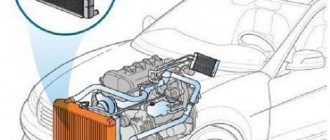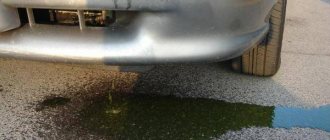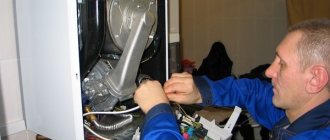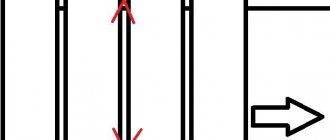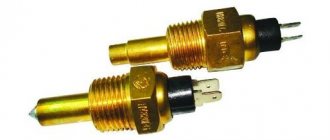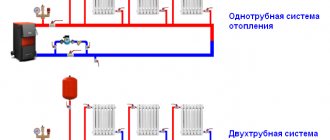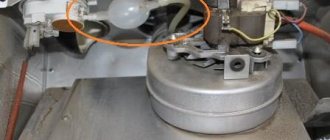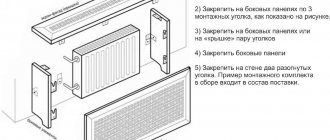The radiator is one of the main components in the car engine cooling system, which is installed in the front part of the body to intake cold air and cool the liquid circulating inside the pipelines. The system constantly operates under high mechanical and temperature loads, which leads to rapid wear and damage.
Very often, it is the cooling radiator that suffers first: small plastic and aluminum segments of the unit crack, through which coolant begins to leak. This is an unpleasant malfunction that is difficult to deal with on the road. However, the radiator needs urgent repairs!
Determining the location of the leak
If the coolant “leaves”, you will immediately know about it by opening the hood and finding a drop in its level on the expansion tank below o.
Next, you need to determine the location of the leak. To do this we do the following:
- Add antifreeze to normal level.
- Warm up the engine to operating temperature.
- We park the car on a flat and dry surface.
- Let the engine cool down.
- We look for where drops of liquid fall under the bottom and carry out a visual inspection of the entire cooling system.
If you are convinced that it is the radiator that is leaking, then it is necessary to take urgent measures to eliminate this malfunction and only then continue to operate the car.
How does a leak appear?
If the radiator is leaking, you need to look for the cause in the integrity of individual elements of the cooling system (engine jacket, hoses, pipes). Damage or deformation of these parts, as well as corrosion and natural wear and tear, often lead to the appearance of cracks through which leaks appear.
Antifreeze can be knocked out through the expansion tank when the engine overheats greatly.
Methods for eliminating identified cooling radiator malfunctions
There are several ways to fix a radiator leak:
- The use of folk remedies (only if you are located at a considerable distance from the nearest spare parts store).
- The use of special sealing agents that temporarily eliminate leaks in the cooling system.
- Repairing a damaged unit using soldering or special adhesives.
- Replacing a damaged radiator with a new one.
Important! The first two methods are purely a temporary measure that allows you to continue operating the vehicle without the risk of engine overheating.
How to fix a radiator leak
One of the reasons that your car radiator is constantly leaking may be a broken radiator cap. Due to old age, the radiator cap may not hold pressure, as a result of which the antifreeze in the system will constantly evaporate. This problem is often invisible to the eye and although the entire system is in order, the antifreeze disappears somewhere. You should replace the cap with a new one and check the antifreeze level after some time. If the level is normal, then the problem is solved.
Radiator fluid often disappears due to wear and tear on the rubber hoses. This is easy to notice by the traces of smudges on the hoses. Such pipes are recommended for replacement, since their repair is not advisable.
The most problematic option is when there is a leak in the radiator itself. Often in such cases, repairs do not help. If there is a large crack in the radiator, it is immediately noticeable by steam and coolant splashes. A large hole can only be repaired in a garage or auto repair shop. Copper or brass can be soldered, aluminum can only be welded with argon. You should know that such repairs are unreliable and even a service station will not give you a guarantee for more than a month.
Folk remedy
If a radiator leak is discovered on the road, then you can get to the nearest grocery store, buy mustard powder or ground red (or black) pepper, and use the proven “old-fashioned” method, which was successfully used even by professional drivers when auto chemicals and its developments did not yet have such wide application.
The method of manufacturing and subsequent use of a homemade repair composition is quite simple:
- Pour mustard powder or ground pepper into a suitable container (at the rate of 1 g per 1 liter of cooling system volume).
- Pour 200÷300 ml of antifreeze or distilled water into it.
- We start the engine, let it run until it reaches operating temperature and turn it off.
- Carefully open the radiator cap (observing the necessary precautions).
- Shake the container with the homemade repair composition and pour the contents inside the unit.
- We start the engine again and let it run for another 15–20 minutes.
Particles of organic matter temporarily stop small holes or cracks that have formed in the radiator: this will allow you to safely reach your destination and carry out a full repair there.
Important! After a complete repair, the entire cooling system must be flushed using special compounds, and only then new antifreeze must be added.
Repairing a cooling radiator using sealant
Leaking car cooling radiator - elimination
You can hear many stories about how car owners ruined their car engine due to the use of sealant. Often these stories are not fiction. So what should you do, use sealant or not? In fact, high-quality sealants cannot damage the engine; many people simply buy cheap analogues or fakes. It is also extremely important to choose the type of sealant that will help in your case. A properly selected composition will restore the tightness of the cooling system.
Types of sealants
There are three types of sealants:
- Powder;
- Liquid;
- Specialized.
Each of these types can cope with routine radiator repairs, but you need to choose them taking into account the size of the crack or hole.
Powder sealant is the cheapest. Often, instead of a specialized powder, car enthusiasts use mustard, which is not recommended. The powder is simply added to the antifreeze if your radiator is leaking. The main disadvantage of using powder is that it severely clogs the radiator channels and tubes.
Liquid sealant is made with the addition of polymers. These sealants can most often be purchased at car dealerships and gas stations. Metal particles are added to it. Liquid sealant clogs the cooling system much less, the main thing is to choose a quality product and not run into counterfeit products.
In addition to polymers, a specialized sealant also contains fibers, due to which it copes with larger damage. Of course, this is the best option among sealants, the only problem is its high price.
It is necessary to understand that the use of sealant is not a solution to the issue of radiator repair, but will only help to get to the place of global repair if the elements of the cooling system are leaking.
How to use sealant
Brief step-by-step instructions:
- Wait until the antifreeze cools down;
- Open the radiator cap;
- Pour sealant into antifreeze;
- Start the engine for a few minutes;
- Shut down and visually check the system for leaks.
If the damage was minor, the seal should be restored. When using low-quality sealants, you can clog the radiator with particles, damage the pump, disrupt the operation of the thermostat, and cause many more problems with the car. To avoid them, carefully study the information on the packages, look at the protection system and all kinds of holograms. When using, carefully follow the instructions included with the sealant. The main thing to remember is that the system with sealant must be restored in the near future.
To avoid major repairs, you should regularly check the cooling system for the slightest malfunctions and leaks, change hoses and pipes in a timely manner, and monitor the temperature of the antifreeze during operation. Also, do not forget to change the antifreeze, as over time it loses its properties, which can lead to problems with the entire system.
If you have any questions, leave them in the comments below the article. We or our visitors will be happy to answer them
Types of radiator sealants
The modern market for auto chemical products is replete with various sealants for eliminating minor damage to radiators. They are produced in the form:
- powder;
- tablets;
- liquids.
According to their intended purpose, such funds are divided into:
- highly specialized;
- universal.
The former are intended for emergency repair of radiators made of either copper (for example, Bar's Leaks Block Seal Liquid Copper) or aluminum (for example, Rislone Liquid Aluminum Radiator Stop Leak). Using the latter (for example, K-Seal ST5501) you can eliminate leaks in the entire cooling system. Moreover, they can be used regardless of the material from which the radiator is made.
Reviews of the use of such drugs vary widely: from the most enthusiastic to the purely negative. The truth is, as usual, somewhere in the middle. It is important to remember that eliminating a leak using one of the proposed drugs is a temporary measure: it only allows you to continue using the car for a period of 2–3 days to several months.
Sealant or spicy mustard
Some will immediately remember another product that was used before the advent of modern means. Some managed to actively use mustard. If someone thinks that it just needs to be torn off and placed in the radiator of the stove, then no. The powder version was popular.
In case of a leak, a substance was poured into the system, then the engine was warmed up. Indeed, after a few minutes of waiting, the leak went away as if nothing had happened. The car calmly continued its movement. How far away, the sources are silent here.
If anyone doesn’t know, when dissolved, mustard powder completely fills all the holes. You can’t explain to the powder that it touches only the required hole without affecting the others. As a result, main channels, tubular elements and components become clogged. Yes, you can actually stop the leak. Only after this will you have to wash or change the parts.
Today, times have changed a little, car enthusiasts have rapidly moved to a new level! Effective means are increasingly being used. Although the principle is the same. Everyone stopped adding powder. But there may be echoes of long ago.
An innovation of the present time is sealants. Please do not confuse this with building materials. This refers to special sealants produced for automobile radiators.
What we would not recommend doing is attempting to pour construction sealant into the system!
After studying reviews on various automotive sites and taking into account their opinions, we can confidently say that sealant is a controversial thing. For some, this is only salvation and a positive result. Others flatly refuse to use them. But there are also those who rationally evaluate strong qualities.
Popular sealants for car radiators
Today, the most popular among Russian car enthusiasts are three types of liquid sealants designed to eliminate small leaks in the engine cooling system: “Liqui Moly Kühler Dichter”, “Hi-Gear Radiator Stop Leak” and “Wynn’s Cooling System Stop Leak”.
The method of application for the above compositions is approximately the same:
- We warm up the engine to operating temperature (so that the thermostat opens and the coolant circulates in a “large cycle”).
- Unscrew the radiator cap (observing safety precautions).
- Thoroughly shake the container with the sealant and pour it into the coolant.
- We install the plug in place.
- Let the engine run for another 15÷20 minutes (until the leak stops).
- If necessary, add antifreeze (to normal level).
The cost of one bottle of liquid gemetic (capacity 250÷325 ml), designed for the volume of the cooling system of a passenger car (from 5 to 12 liters) varies from 300 to 400 rubles. According to the manufacturers, the above compositions are compatible with all types of antifreeze currently used in cooling systems.
Selecting repair methods and adhesives
There are several ways to restore the integrity and tightness of the cooling radiator:
- Soldering. The body elements of modern car radiators, made of heat-resistant plastic, can be easily soldered using a conventional soldering iron (we will look at this process in more detail below).
- Cold welding. This is the fastest way to join plastic parts without heating. A special plastic mass, which includes polymer resins, metal filler and chemical additives, connects the bonded surfaces, forming a heat-resistant seam.
This process does not require special equipment, but such repairs cannot be called durable.
Due to the low adhesion of plastic, cold welding holds very weakly. This method allows you to only temporarily solve the problem (for example, to get to the nearest car service center).
- Application of glue. If the damage is minor, special glue will help restore the seal of the case.
The following compositions have proven themselves to be excellent:
Two-component adhesive 3M DP8005 is a specialized acrylic-based composition designed for gluing difficult-to-glue plastics, polyethylene, and polypropylene.
Perfect if you need to seal a radiator crack . The adhesive joint formed by DP8005 adhesive from the 3M brand is resistant to aggressive solutions and high temperatures.
The only drawback of this glue is its high price (1300-1500 rubles per 38 gram package).
Adhesive welding for plastics Hosch. This two-component industrial adhesive effectively repairs cracks and other damage in any plastic products.
The adhesive joint can withstand high and low temperatures, as well as pressure up to 12 atmospheres, so it can be used to glue a plastic radiator .
Often the joint is stronger than the plastic being glued together. The average cost of a set of two complementary components is 1500-1700 rubles.
Preparatory stage of radiator repair
Before you begin repairing the radiator yourself, it is necessary to carry out a number of preparatory measures:
- Drain the antifreeze from the cooling system.
- We dismantle the radiator, clean it of dirt and dust and rinse it thoroughly.
- We “muffle” all technological openings (inlet and outlet) using improvised means (for example, pieces of plastic film and electrical tape).
- We lower the radiator into the bathtub filled with water.
- Based on the air bubbles rising to the top, we determine the location of the damage.
When the “problem” areas are clearly identified and the radiator is thoroughly dried, you can immediately begin the repair process.
Soldering the radiator: method 1
It includes the following steps:
- Surface preparation. This process must be done carefully. It consists of cleaning the treated area from all dirt and paint residues. Clean the aluminum surface using emery cloth and solvent. Preparation also includes degreasing the treated area (for this, preparations containing alcohol are used), as well as wiping the metal dry.
- Preparation of iron rosin flux. To do this, the crucible is placed on a gas stove and heated. You can heat it with a blowtorch. A piece of rosin is placed in a heated crucible. It needs to be completely melted. Next, add iron filings little by little and immediately stir the mixture. The ratio of rosin and sawdust should be 2:1.
- Applying flux to the prepared area. The solution is applied so that the desired part of the radiator surface is completely covered. Otherwise, oxygen will have access to the aluminum, and the hole will not be soldered well. At the end, the entire soldering surface should be under a layer of flux.
- Soldering. It involves introducing solder into a liquid flux environment. You need to take small portions of solder onto the soldering iron. Solder is applied to the soldering area so that it is under the flux layer. At the same time, perform circular movements. During these movements, the soldering iron constantly dislodges some particles of solder. The displacement of iron particles leads to the destruction of the oxide film. Rosin prevents air from penetrating the aluminum.
Soldering a copper or brass radiator
Repairing minor damage to radiators made of copper or brass is quite simple. For this you will need:
- Gas burner (the simplest nozzle for a cylinder costs only 200–250 rubles).
- Solder paste (for example, ZIL-2 or ST-61).
- Tin-based solder (POS-30, POS-40 or POS-60).
Work algorithm:
- We clean the damaged areas using sandpaper and needle files.
- We warm them up using a gas burner.
- Apply a layer of solder paste or acid.
- We apply a solder rod to the hole or crack and continue to heat the soldering area with a gas torch.
- We make sure that the melting solder evenly fills all damaged areas.
- After complete cooling, remove excess tin mechanically.
- We close all the holes of the radiator, lower it into a bath filled with water, and make sure that there are no air bubbles in the soldering areas.
Finding a leak
The simplest and most effective way to detect a leak in a radiator is to dismantle and immerse the radiator with clogged pipes in a bath of water. Where there is a hole, water will flow in and air bubbles will begin to form.
If the leak is too small, it may not be detected naturally. Then you should connect a compressor or pump to one of the pipes to increase the internal air pressure in the radiator tubes.
A more reliable way to detect the smallest leaks is diagnostics using fluorescent components, which make it possible to detect even microscopic leaks in the seal of the radiator housing. But this is an expensive diagnostic that can only be carried out at a service station.
Repair of aluminum radiators
Until recently, exclusively special oxygen-free argon welding was used to repair products made of aluminum and its alloys. This was due to the fact that after mechanical cleaning of the damaged area, an oxide film instantly formed on the surface of the material, which made soldering difficult. Nowadays, with the advent of low-temperature solders (Durafix or HTS-2000), designed specifically for soldering aluminum, repairing a radiator made of this metal at home does not present any particular difficulties:
- We clean the damaged areas mechanically.
- We degrease them with alcohol or solvent.
- We heat the damaged area using a gas burner.
- We press a rod of special solder tightly against it and carry out reciprocating movements. By doing this, we remove the layer of oxides from the surface, and the solder, which melts upon contact with the heated surface, reliably “blocks” the radiator leak.
How to solder plastic car cooling radiator (instructions)
Soldering an engine cooling radiator is considered a fairly simple task. However, not everyone can cope with it due to insufficient knowledge of how to solder a car radiator on their own. Most car owners prefer to take their car to a service station.
If you are confident in your abilities, then first you should determine how to seal the plastic radiator. Next, let's look at step-by-step instructions that will help you make a truly high-quality and durable repair of the plastic parts of the part.
Surface preparation
Before gluing the plastic on the car radiator, you will need to thoroughly prepare the surface for this process. For this purpose, we will need to clean it from grease, dust and dirt. Lightly dampen a rag and very carefully wipe the areas of plastic around the resulting crack.
In order to achieve a better effect, it is recommended to use an alcohol solution. It is important that in no case should you overdo it. The fact is that too active mechanical impact on the damaged area or excessive pressure on it when cleaning can damage the heat exchanger even more.
Preparing the adhesive mixture
Now you need to worry about how to seal the crack on the car radiator. So, let's prepare the adhesive mixture. If you decide to use exclusively glue specially designed for such purposes, then its use will be as simple as possible.
A small amount of adhesive should be applied directly to the damaged area. When a part is missing a certain piece of the body or there is no gap between the two halves that are formed due to a crack, it is recommended to sprinkle the liquid base with the powder component of the glue.
So, if the crack itself is too deep or a sufficiently large part of the body is missing, gluing must be performed in several stages. You should apply glue to the damaged area two or three times, waiting until each layer is almost completely dry. When the resulting gap can be completely filled with dry gradulant, it is recommended to saturate it with a liquid composition. This way you can be completely confident that it will adhere perfectly to the surface of the spare part.
This is interesting: The car does not start when the starter is spinning - how to fix it?
Cold welding
In addition, you can seal a car radiator using cold welding. Since it comes in the form of a fairly thick putty, it will be enough to apply it to the seam and wait until it cools completely. It is important that this putty must be applied in a neat and even layer so that the seam is of the highest quality.
Cold welding must be used as:
- the main method of restoring performance;
- an additional means of securing the result obtained by soldering or gluing.
A layer of cold welding applied on top of the glue layer will allow you to preserve the quality of the auto part repair for a long time and extend the service life of the part.
Final stage
When the glue has completely hardened and all the main working steps have been completed, you need to carry out final surface treatment. It is necessary to ensure that the resulting seam becomes neat and smooth. For such purposes, the soldering area will need to be treated with fine-grained sandpaper, and ideally with a grinding machine.
In this way, you will be able to get rid of all minor defects that will not have the best effect on the further operation of the product. After this treatment has been completed, install the heat exchanger back in its place.
How can you seal a car radiator?
The use of “cold welding” or special adhesive compositions is also a very effective measure to extend the “life” of your car’s radiator. Work algorithm:
- Use a narrow screwdriver to widen the crack.
- We thoroughly clean it with needle files or sandpaper and degrease it.
- We mix the “cold welding” components (“Poxypol”, “Moment”, “Arbo” or the like).
- Fill the gap with the prepared solution and leave the knot for a day to dry completely.
- We check the radiator for leaks and install it in place.
Damage to radiators (made from a wide variety of materials) can be quickly and effectively repaired using a special Hosch-Kleber repair compound. The delivery set includes two containers:
- one with liquid adhesive;
- the other with special welding granulate.
How to use this tool to repair a car radiator is described in the video below:
How to fix a car radiator leak using cold welding
Cold welding is often used to seal small cracks. It should be applied to a cleaned surface from which all contaminants must be removed. When the weld hardens, the crack will be sealed. Such repairs are not very reliable, since under the influence of high temperatures, cold welding loses its properties and becomes colored.
Some car owners, when their radiator is leaking, use “folk” methods to fix the problem. For example, they add dry mustard, which swells due to temperature and covers the cracks with its particles. Such repairs may result in large repair costs in the future. The channels, every thin tube, and even the coolant drain valve will become clogged. A faucet is essential when replacing a radiator, especially if you plan to do it yourself. A clogged tap will prevent you from draining the coolant and there will be problems with replacement. It’s better not to take risks and not use mustard, but to get to the repair site by constantly adding antifreeze.
